Assessing On-Farm Risks and Documenting Food Safety Practices to Meet Farm to School Requirements
ID
SPES-319NP
Introduction
Growers wanting to access the farm to school market, need to thoroughly understand a school district’s food safety policies in order to satisfy requirements for food purchases. While a third-party GAP (Good Agricultural Practices) audit and certification is neither a federal or state requirement, some school divisions may still require it in Virginia. Yet, regardless of whether or not an audit is required, recognizing and having a good grasp about potential on-farm produce safety hazards (Figure 1) and incorporating best food safety practices (GAP) for reducing potential produce contamination are critical when selling to schools. In addition, it is important to know how the schools will verify food safety practices (i.e. verbal or written agreements, farm visits, reviewing food safety plan or records, etc.). In this publication, we will take a closer look at the process for identifying hazards to provide a context for addressing them and using a checklist document as a verification tool.
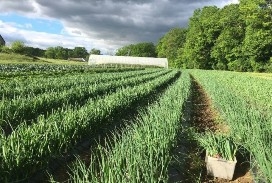
Identifying Hazards
There are three types of main hazards related to on- farm contamination (Figure 2). Biological hazards include bacteria, viruses, parasites, yeasts, and molds that cause foodborne illness. Chemical hazards include cleaning products, lubricants, paints, petroleum products, bulk fertilizers, and pesticides. Physical hazards include debris, nails, screws, staples, metal, glass, wood, and plastic. While chemical and physical hazards need to be addressed, biological hazards pose the greatest concern because of pathogens. Human pathogens (biological hazard) are microorganisms that cause disease or illness in people. Understanding how the produce being grown can become contaminated by the three types of hazards is critical for pinpointing potential problem areas and implementing GAP.
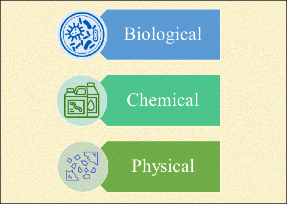
How Hazards are Introduced and Spread
When considering production, harvest, and post- harvest environments, there are several primary ways or routes that contamination of the produce can occur. These routes include: humans (e.g., workers, visitors); water (e.g., irrigation, spray applications, frost protection, post-harvest washing, ice); biologically-based soil amendments (e.g., manure, compost, compost teas); animals (e.g., birds, deer, livestock, pets); and tools, equipment, vehicles, and facilities (e.g., knives, containers, harvest machinery, food-contact surfaces, packing lines, storage areas).
Humans are one of the key ways contamination can be spread. It is important to include toilet and handwashing facilities, and also provide training for anyone who will be engaged with the production, harvest, and post-harvest activities on the farm. Visitors also need to be aware of best practices and have minimal exposure to any of the production, harvest, and post-harvest facilities (Figure 3).
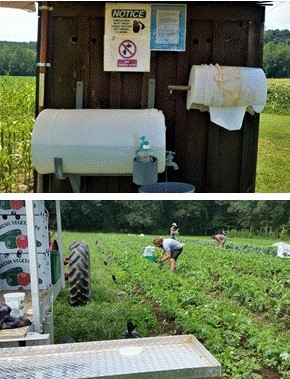
Agricultural water, whether for pre-harvest or harvest/post-harvest operations, should be of adequate quality for the intended use (Figure 4). Water systems should be inspected regularly to ensure filters, pumps, connections, and lines are functioning properly. Water should also be tested to determine microbial quality. Standards vary based on water source, and application method and timing, and are set by buyers, audit criteria, or federal regulation. When water test results do not meet microbial standards, corrective actions should be taken and the water re-tested.
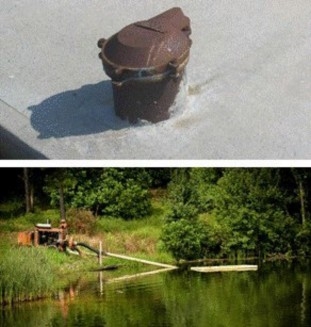
Biologically-based soil amendments and animals pose risks since they can spread pathogens via fecal contamination. If raw manure is applied to production areas, they should follow National Organic Program standards between application and harvest (USDA 2021). For composted amendments containing manure, it is important that they have been properly composted to ensure adequate temperature, moisture, turning, and time for decomposition. Animal risks should be assessed, monitored, and actions taken to minimize intrusion through deterrence steps (Figure 5).
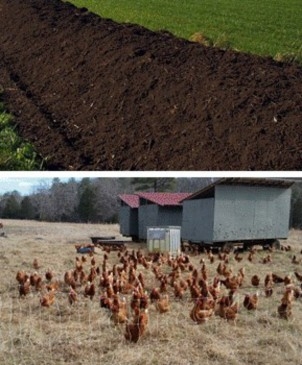
Tools, equipment, vehicles, and facilities serve as a means for spreading contamination when they are not properly cleaned, sanitized, and maintained (Figure 6). It is always critical to make sure to reduce the risk of spread when using tools and vehicles that are moved from place to place. When possible, separate tasks or use designated tools and equipment for specific activities where cross contamination is more likely (i.e. using tools for moving livestock manure and then using the same tools for production or harvest activities).
As you consider the above routes of contamination, always think about them in the context of the crop being grown and specific stage of production and handling: pre-plant stage, production stage, harvest stage, and post-harvest handling stage (Figure 7). Doing so will help you identify what potential risks exist at each stage. For more information about the routes of contamination, see Bihn et al. 2014 and Vallotton et al. 2018.
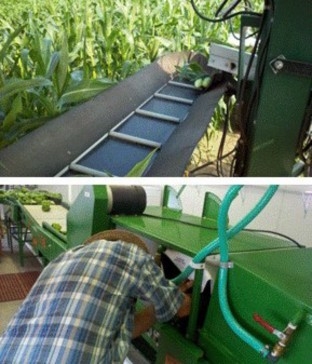
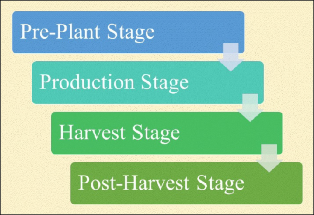
Pulling it all Together to Create an Assessment of On-Farm Risks
Within the above context, one of the best ways to help you determine on-farm risks is to create a sketch of your farm. To get oriented, first obtain an aerial map that shows the entire farm area with natural features and structures. Sources like Google Earth maps, Natural Resources Conservation Service (NRCS), county GIS maps, or Farm Service Agency (FSA) can all provide a good starting point. Print out the map(s) and then sketch the location of fields showing various production areas (fields, high tunnels, greenhouses, up for packing areas, you can create additional sketches to better detail packing tables, wash systems, coolers, and other storage areas. Sketches do not need to be overly fancy. The goal is to have enough detail to consider risks.
As you create your maps and sketches, outline your entire process on a separate sheet of paper. If you grow multiple crops, you will need to consider pre- plant, production, harvest, and post-harvest handling practices for each crop (Figure 8). You will use your map, sketch, and outline to focus on three primary questions:
What are the potential hazards (biological, chemical, physical) at each stage?
What are the sources or routes of contamination at each stage?
What practices can be implemented at each stage to minimize hazards?
The checklist provided on the next two pages is a great starting point targeted to identify on-farm risks at each stage. Along with your maps and sketches it can be used as a simple record to document you conducting a risk assessment and adhering to preventive food safety practices. While the assessment is not a substitute for a complete food safety plan (which typically includes policies, standard operating procedures, and records), or other certification/inspections, the assessment is still a document demonstrating you identified and understood potential risks. Don’t forget it is important to ask specific buyers what they require to satisfy their food safety policies.
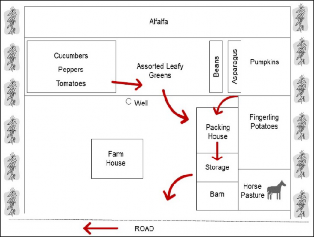
The movement of crops harvested from a field into a packing house area into a storage unit and then transported via a road is shown using red colored line with arrows. (Vallotton)
Resources
Bihn, E.A. et al. 2014. On-Farm Decision Tree Project. Cornell University.
Google Earth. Accessed May 2021.
USDA. National Organic Program. Accessed May 2021.
Vallotton, A. et al. 2018. Virginia Produce Safety Website. Virginia Tech.
Web Soil Survey (USDA NRCS) website. Accessed May 2021.
Implemented On-Farm Food Safety Practices Checklist
Check boxes for all items you have completed as a part of your on-farm food safety program. For items that do not apply, write N/A next to item.
General (applicable to all stages)
▢ All workers, including family members, have been trained in proper health, hygiene, and produce handling practicesand policies for any of the stages they are involved in.
▢ Visitors are instructed in expectations, especially if they are allowed in any production and packingareas.
▢ Appropriate signage is posted to remind workers and visitors of food safety practices and policies.
▢ Port-a-johns or indoor restrooms and wash stations are readily available.
▢ All workers and visitors wash hands after using the restroom and at other specified times as stated in training/policy
▢ Eating is only permitted in designated eating areas.
▢ Drinking water is only allowed in different areas if containers are not breakable.
▢ Smoking, if permitted, is never allowed in production and handling areas.
▢ Anyone who is exhibiting signs of an infection, sickness, or has an accident knows to report to the supervisor and not work around produce until authorized to do so.
▢ A first aid kit and emergency contact numbers are readily available.
Pre-Plant Stage
▢ For each crop being grown, I have identified any risks known to be associated with the crop (i.e. netted rind, stem scars on fruit, or high-risk crop in terms of related outbreaks, etc.).
▢ For the different kinds of plant material I am using for plant propagation (i.e. seeds, transplants, bulbs, tubers, rootstocks), I have maintained and stored appropriately prior to planting.
▢ For seed starts and transplants, I have made sure seed flats are clean and not a source of contamination
▢ Prior to field preparation, including protected culture (i.e. greenhouses, high tunnels), I have determined that the prior land history does not pose contamination risks to current production areas. This includes:
- Previous flood events
- Septic system drain-field areas
- Chemical spills or dump sites
- Previous early 1900s orchards
- Concentrated livestock operations
▢ Where possible, production fields are not located where there is a potential for runoff from livestock or grazing areas.
Production Stage
▢ For field preparation, I have made sure any equipment and tools used are not a source of contamination.
▢ Soil amendments, such as manure or biologically-based compost, have been applied 120 days prior to harvest.
▢ For any purchased composts used, I have a certificate of analysis, which provides information about the different inputs used to make the compost, the composting process, and contact information for the manufacturer.
▢ Any bulk fertilizers and plant protection products are stored in such a way as to prevent contamination.
▢ For protected culture systems being used, steps are taken to reduce risks:
▢ Channels, containers, and rafts, are regularly cleaned and sanitized between rotations
▢ Overhead lights are protected to prevent breakage
▢ Acids used for lowering pH are stored so as to prevent accidents and contamination
▢ The sources and quality of production water (irrigation, frost protection, plant sprays) being used is tested at least annually.
▢ Production areas are monitored for evidence of animals such as animal tracks, feces, droppings, trails, damaged crops.
▢ Measures are taken to exclude or deter wildlife.
▢ Domesticated animals are not allowed in production and packing areas.
▢ Outdoor and indoor spaces, are kept clean to reduce rodent habitat and refugia.
Harvest Stage
▢ Harvesting tools, bins, and totes are cleaned and sanitized prior to use.
▢ Harvest wagons and machinery are in good repair and lights protected to prevent glass breakage.
▢ Harvest equipment is not a source of cross contamination.
▢ When harvesting, any produce showing signs of visible contamination is discarded.
Post-Harvest Handling Stage
▢ Harvested produce brought from fields or protected culture areas is handled so as to prevent cross contamination.
▢ In open pole barn structures, measures have been taken to prevent bird roosting, as well as live traps set for rodents.
▢ For indoor packing area, non-baited, live rodent traps are used and regularly checked.
▢ Light fixtures are protected to prevent glass shattering over product.
▢ Food contact surfaces are made of construction materials that can be cleaned and sanitized prior to use.
▢ Prior to repacking, all dirt, mud, and other debris is removed from produce.
▢ All wash water, when used, is tested annually to ensure it is potable. Test results are kept on file.
▢ When a sanitizer is added to wash water, it is monitored to make sure it is working.
▢ Boxes and containers used for re-packing are stored to prevent cross-contamination.
▢ Cardboard boxes are new, or if re-used, are free from signs of soiling and always lined with new plastic.
▢ Repacked product has identifiable traceback codes to provide a traceability system.
▢ Storage coolers are kept cleaned, maintained, and do not contain both produce and non- produce items (such as meat).
▢ Produce in coolers is kept at appropriate holding temperatures, which are monitored.
▢ When produce is put on ice, the water used to make the ice is from a potable source.
▢ Transport vehicles are clean and well maintained to maintain cold chain to the marketplace.
Notes
Name
Signature
Farm Address
Date
Virginia Cooperative Extension materials are available for public use, reprint, or citation without further permission, provided the use includes credit to the author and to Virginia Cooperative Extension, Virginia Tech, and Virginia State University.
Virginia Cooperative Extension is a partnership of Virginia Tech, Virginia State University, the U.S. Department of Agriculture (USDA), and local governments, and is an equal opportunity employer. For the full non-discrimination statement, please visit ext.vt.edu/accessibility.
Publication Date
May 7, 2021



